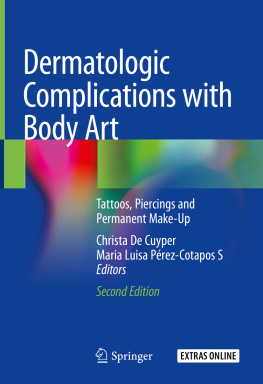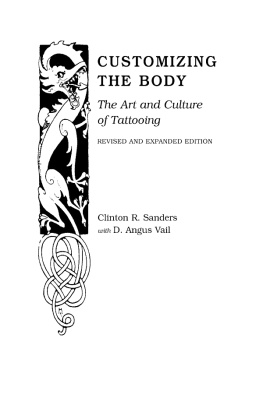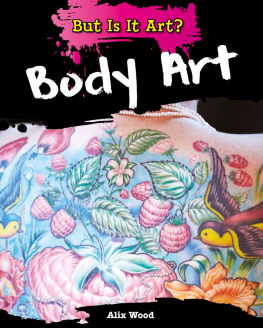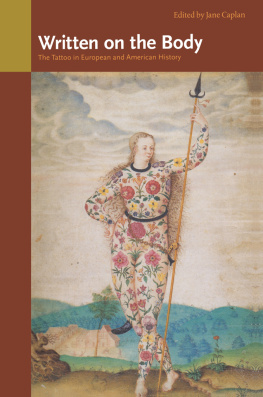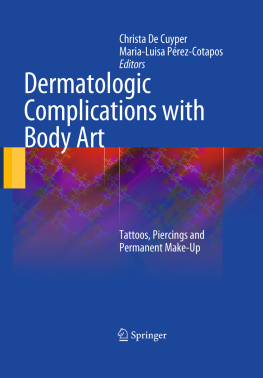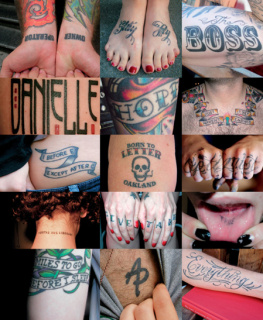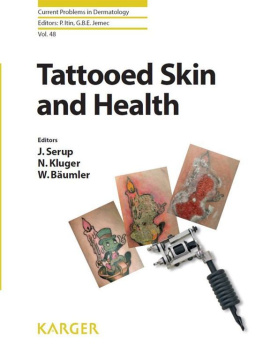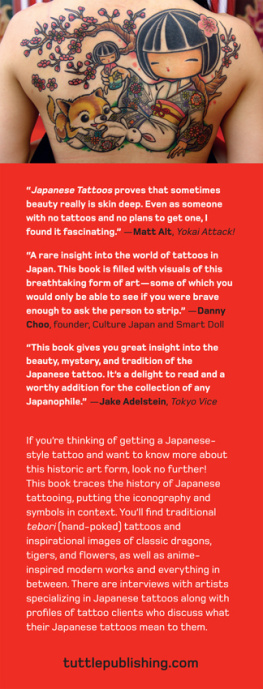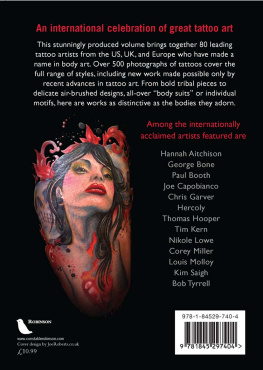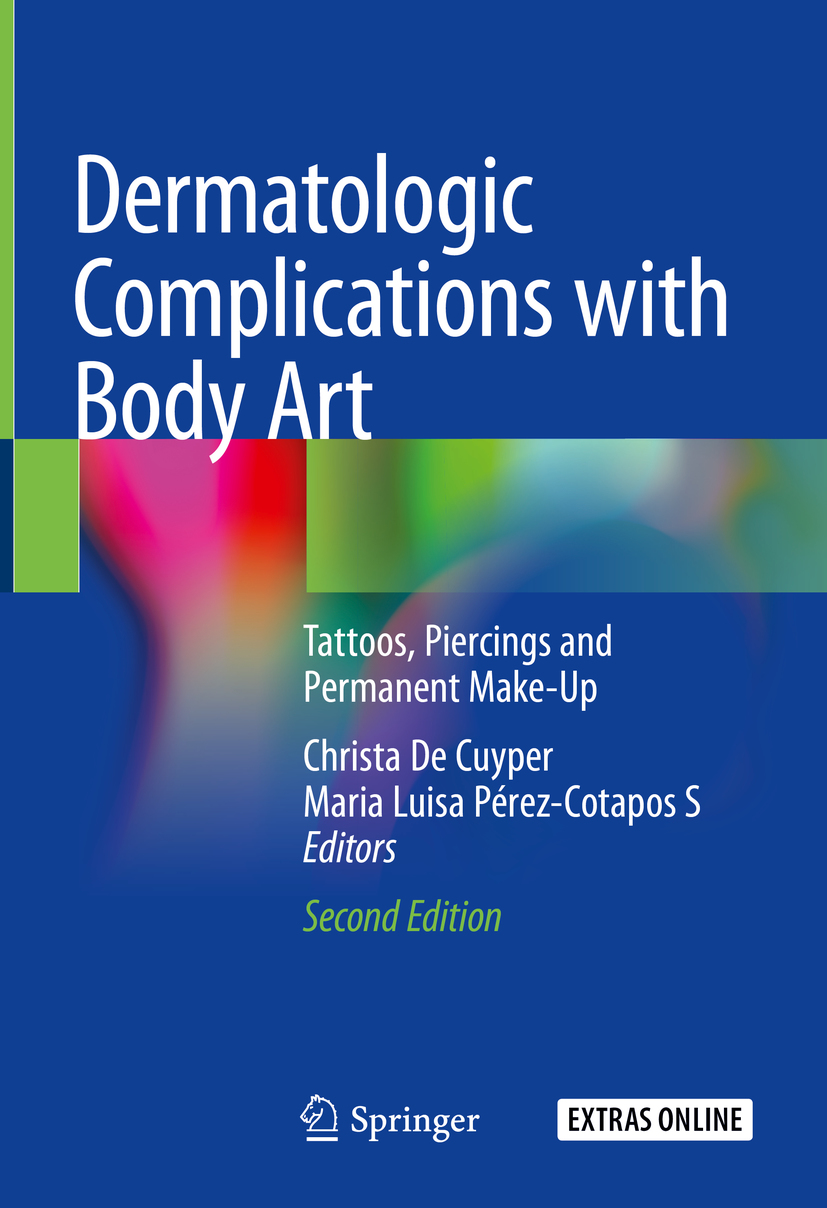Editors
Christa De Cuyper and Maria Luisa Prez-Cotapos S
Dermatologic Complications with Body Art Tattoos, Piercings and Permanent Make-Up 2nd ed. 2018
Editors
Christa De Cuyper
Department of Dermatology, AZ Sint-Jan Brugge, Oostende AV, Belgium
Private Practice in Dermatology, Blankenberge, Belgium
Maria Luisa Prez-Cotapos S
Department of Dermatology, Clinica Las Condes, University of Chile, Santiago, Chile
ISBN 978-3-319-77097-0 e-ISBN 978-3-319-77098-7
https://doi.org/10.1007/978-3-319-77098-7
Library of Congress Control Number: 2018942637
Springer-Verlag Berlin Heidelberg
Springer International Publishing AG, part of Springer Nature 2018
This work is subject to copyright. All rights are reserved by the Publisher, whether the whole or part of the material is concerned, specifically the rights of translation, reprinting, reuse of illustrations, recitation, broadcasting, reproduction on microfilms or in any other physical way, and transmission or information storage and retrieval, electronic adaptation, computer software, or by similar or dissimilar methodology now known or hereafter developed.
The use of general descriptive names, registered names, trademarks, service marks, etc. in this publication does not imply, even in the absence of a specific statement, that such names are exempt from the relevant protective laws and regulations and therefore free for general use.
The publisher, the authors and the editors are safe to assume that the advice and information in this book are believed to be true and accurate at the date of publication. Neither the publisher nor the authors or the editors give a warranty, express or implied, with respect to the material contained herein or for any errors or omissions that may have been made. The publisher remains neutral with regard to jurisdictional claims in published maps and institutional affiliations.
This Springer imprint is published by the registered company Springer International Publishing AG part of Springer Nature
The registered company address is: Gewerbestrasse 11, 6330 Cham, Switzerland
Preface
Body modification is a common human characteristic that has been practiced on all continents and in all races since ancient times. Specific types of body art have been associated with specific social, ethnic and religious societies. Permanent modifications such as piercing and tattooing are common forms of body adornment. In the last decades they have been promoted as a fashion statement by celebrities and nowadays they are accepted in all social classes. Cosmetic tattoos or permanent Make-Up (PMU) have been introduced as an alternative for conventional Make-Up. Tattoos are also used in medical procedures, e.g. for field demarcation in radiation oncology and endoscopic surgery. Tattooing, also known as dermatography, has found its place to camouflage pathological skin conditions such as vitiligo and alopecia or to mask scars and birth marks and it can offer the finishing touch in reconstructive surgery. Its use can also be extended to therapeutic indications and for the implantation of pharmacological substances. Tattooing is only one aspect of body art. The imagination in body adornment and body transforming techniques is amazing and endless. Piercing is often combined with stretching, tunnelling and embedding of jewels. Invasive body-modifying techniques such as implanting, scarification, branding, scalping and even amputation seem to attract the young population; unfortunately these procedures often result in impressive, irreversible body mutilation. All body-modifying methods can lead to complications, which depend on the hygienic conditions in which the procedures are performed, on the training and the skills of the practitioner and on the materials. Allergic reactions can be attributed to the substances used. Poor hygienic standards and careless procedures can result in localised infections but can also lead to severe life-threatening conditions or even result in irreversible damage. Blood-borne diseases can be transmitted (hepatitis B, C, HIV); granuloma and keloid formation can occur. Health care professionals should be aware of the complications that can arise from these procedures.
The body art industry is one of the fastest growing industries in the last years unaffected by the economic crisis. Considering the high number of people that have chosen for a tattoo, a piercing or any other form of body modification, one can estimate that millions of people on the globe live with a self-inflicted health risk with consequences for the health care system in general. Many efforts have been made yet to identify risk factors and to develop preventive measures aimed at protecting public health. Regulation of the composition of the products, harmonisation of the methods for the analytical determination of possible harmful substances, guidelines and recommendations to ensure that procedures are carried out under appropriate hygienic conditions can offer a big step forward to promoting consumers health. However there is still a lack of uniform universal regulations and control. Recently, new initiatives have been taken by the Council of Europe and by the European Commission to improve the safety of the procedures and the materials, more in particular to limit the risk of side effects caused by poor hygiene and unsafe substances.
The purpose of this book is to illustrate the different aspects of body art starting from the history through epidemiology, to improve the knowledge about materials, with their toxic and allergenic potential, to describe the procedures and the complications that can arise. Cosmetic and medical indications and therapeutic modalities of tattooing will be addressed. A separate chapter is dedicated to tattoo removal with a focus on laser techniques.
To realise this book we had the assistance and contributions of many people whom we would like to thank, in particular the members of the European Society on Tattoo and Pigment Research (ESTP) for their advice, our colleagues, our secretaries and our families for their help and support.
Christa De Cuyper
Maria Luisa Prez-Cotapos S
Blankenberge, Belgium Santiago, Chile
Acknowledgements
Yves Bogaerts
Videos and figures
Blankenberge, Belgium
Sandy Verfaille
Inksane, Roeselare, Belgium
Kim Maertens
Inksane, Roeselare, Belgium
Elayne Angel
The Piercing Bible, Merida, Mexico
Darline Vierstraete
The Color Studio, Waregem, Belgium
Jolle Senden
Aalst, Belgium
Bieke Heykants M.D.
Da Vinci Clinic, Beerse, Belgium
Els Wittouck M.D.
Dermatology AZ Sint-Jan Brugge-Oostende AV Belgium
Jens Bergstrm
Tattoo and Piercing Education Scandinavia, Akersberga, Sweden
Liz Kierstein
Tattoo Liz, Copenhagen, Denmark
Urs Hauri
Association of the Cantonal Chemists of Switzerland, Basel, Switzerland
Contents
Anne E. Laumann and Nicolas Kluger
Christa De Cuyper and Davy Dhollander

